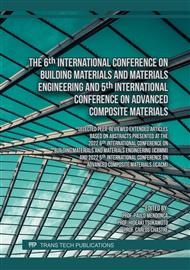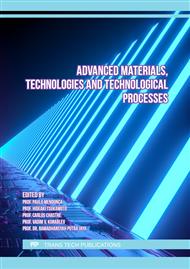p.49
p.55
p.65
p.71
p.77
p.83
p.95
p.103
p.117
The Antimicrobial Potential of Vanillin-Incorporated Irreversible Hydrocolloid Impression Material
Abstract:
The hydrocolloid impression material is one of the most important materials extensively used in several procedures in the dental field. It is mainly applied for diagnostic and planning in the rehabilitation of oral, orthodontic, and maxillofacial prostheses due to its biocompatibility with the oral tissues, low toxicity, ease of use, and relatively low cost. When doing the impression, the material might be contaminated with blood, saliva, and biofilm from within the patient’s mouth. In these procedures, there are high chance that the microorganisms can be transmitted from patients to the casting materials and then to the dentists or to the dental lab technicians. Several types of disinfectants have been introduced for use to disinfect dental impressions. This study aims to investigate the antimicrobial potential of vanillin-incorporated irreversible hydrocolloid impression material on Staphylococcus aureus, Klebsiella pneumoniae, Escherichia coli, and Candida albicans. The hydrocolloid impression material used in this study is Alginate, Kromopan class A type I, Lascod, Italy. Different concentrations of vanillin (0.1%, 0.5%, and 1% w/w) were added to the impression powder, and the impression samples were made by mixing the alginate powder with water and pouring them on sterile plastic plates. Staphylococcus aureus ATCC 5638, Klebsiella pneumoniae (clinical isolate), Escherichia coli ATCC 11775, and Candida albicans ATCC 10231 were prepared to 105 CFU/ml suspensions in sterile normal saline solution. A total of 100 μL of each microbial suspension was evenly spread onto the surface of the impression and left for 1 min. Then, a 2 x 2 cm2 sterile Whatman filter paper was placed on the impression sample surface to make an imprint and transferred to the Brain Heart Infusion (BHI) agar plate. The number of colonies growing on the BHI agar was counted after incubation at 37°C for 24-48 h. Impression material without vanillin was used as a control. It was found that adding vanillin to the materials could significantly inhibit all tested microorganisms, and the inhibitory efficiency ranged from 12% to 98%. K. pneumoniae showed the most resistance since the inhibitory effect started at 0.5% w/w vanillin and the maximum suppression was 84% at 1% w/w vanillin. On the other hand, S. aureus appeared to be the most sensitive species, as the suppressive response started at 0.1% w/w vanillin and the percentage of inhibition was as high as 98% at 1% w/w vanillin. In conclusion, we combined different concentrations of vanillin (0.1%, 0.5%, and 1% w/w) into the impression material and it showed a significant antimicrobial potential against all tested oral bacteria and yeasts (S. aureus, K. pneumoniae, E. coli, and C. albicans). The suppressive effects were dose-dependent and ranged from 12% to 98%. This did not only disinfect the impression material from the inside but also disinfected the impression from the time it was inserted into the patient’s mouth. Using this hydrocolloid impression material incorporated with vanillin could be beneficial to eliminate cross-infection for dental personnel. Nonetheless, further studies are necessary to investigate some physical properties of this impression material, such as setting time, tensile strength, elastic recovery, and detailed reproduction.
Info:
Periodical:
Pages:
77-82
Citation:
Online since:
March 2023
Keywords:
Price:
Сopyright:
© 2023 Trans Tech Publications Ltd. All Rights Reserved
Share:
Citation:



